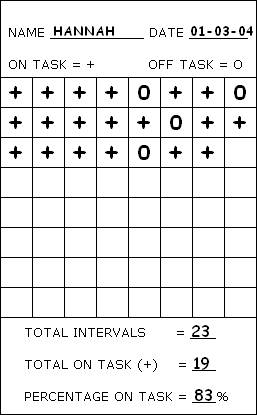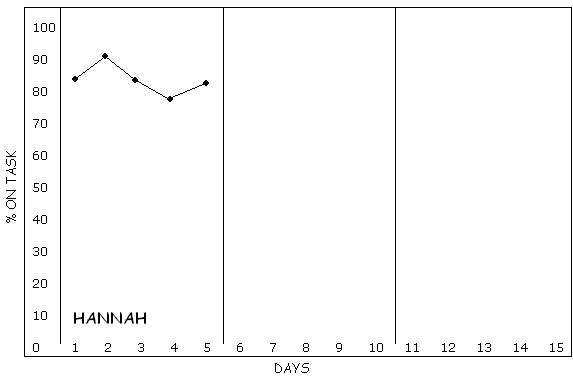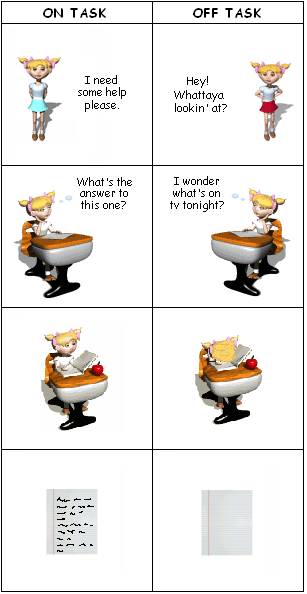SELF-mo: A Hypothetical Case
Hannah is a student in a special education classroom who is seldom on task for more than 10% of the times observed. Her teacher puts Hannah on a token economy. Because the teacher is going to be responsible for implementing each of the three components in the intervention, we may say that she is using EX-mo (the XTRA-strength kind) to modify Hannah's on-task behavior. Hannah is given work the teacher knows she can complete successfully and is told that her teacher will look at her at different times during the day to see if she is "on task." The latter is explained to Hannah as meaning any one or a combination of the following behaviors: a) looking at the task, b) doing the task, and/or c) talking about the task with the teacher or a peer.
Assessment Component:
The teacher sets a timer in her pocket and goes about her teaching. When the timer rings, she looks at Hannah. If Hannah is engaging in one or more of the three on-task behaviors, the teacher records a plus in one of the boxes on a rating card she carries (see figure 1.1). If Hannah is not engaging in any of the above behaviors, the teacher records a zero in a box on the card. She then resets the timer and returns to her teaching. This process continues throughout the day whenever Hannah is required to perform quiet independent seatwork.

Figure 1.1 Rating Card Blank
Reinforcement Component:
When the period is over, the teacher computes the percentage of Hannah's on-task behavior by dividing the total number of boxes marked with plusses and zeroes into the total number of boxes marked with plusses (see figure 1.2). If Hannah has reached the designated goal for the day, she receives a pre-determined number of tokens from the teacher that she may turn in later in the day for a free-time activity or save in her token bank to spend at a later date.

Figure 1.2 Rating Card Completed
Monitoring Component:
Hannah's teacher records each day's on-task percentage on a chart (see figure 1.3) to determine how effective the intervention is.

Figure 1.3 On-Task Chart
Let's assume that over time, the intervention is effective and Hannah's percentage of on-task behavior increases from 10% to 60%. At this point, because of other demands on her time, the teacher decides to give Hannah some responsibility for operating the intervention.
Not wanting to overwhelm Hannah with all three components of the intervention at once, her teacher decides to gradually give her more responsibility in phases. Here's how Hannah's teacher changes what began as an EX-mo program into a SELF-mo program.
Phase One:
Everything stays the same except that Hannah is given the rating card when the day's rating is done and has to 1) compute the percentage of her on-task behavior, 2) plot it on her chart, 3) tell the teacher how many tokens she has earned for the day, and 4) retrieve the tokens from the token bank on the teacher's desk.
Phase Two:
Same as phase one above except that Hannah keeps the rating card at her desk and is told by the teacher what to write in each box (i.e., a plus or zero) each time the timer rings.
Phase Three:
Same as phase two above except that when the timer rings, the teacher asks Hannah to decide whether she was on task and to record it on her rating card. Hannah has a "cheat sheet" (see figure 1.4) taped to her desktop to help her assess her behavior.

Figure 1.4 Cheat Sheet
Phase Four:
Same as phase three above except that Hannah keeps the timer and, without looking at it, sets it to ring at random intervals. Hannah is now responsible for the operation of the entire intervention. In other words, she is doing SELF-mo.